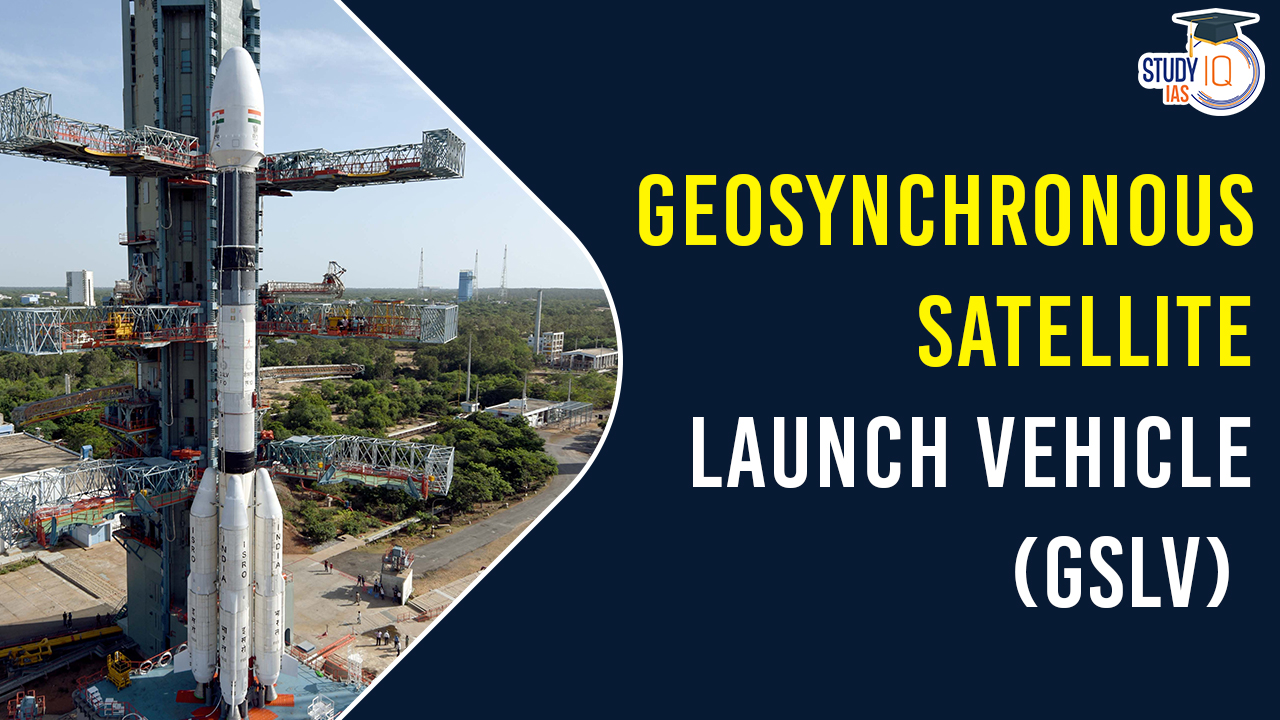Table of Contents
The Geosynchronous Satellite Launch Vehicle (GSLV) is a space launch vehicle developed and operated by the Indian Space Research Organization (ISRO) for launching satellites and other objects into Geosynchronous Transfer Orbits. GSLV is capable of carrying heavier payloads into orbit compared to the Polar Satellite Launch Vehicle (PSLV).
ISRO’s GSLV rocket, nicknamed ‘naughty boy’, due to its mixed record of successes and failures, and its role in advancing India’s space capabilities with the latest satellite launch INSAT-3DS.
Geosynchronous Satellite Launch Vehicle (GSLV)
The Geosynchronous Satellite Launch Vehicle (GSLV) is designed for deploying 2.3-ton class satellites, including communication satellites like INSAT and GSAT, as well as spacecraft from the INRSS and IDRSS series, into Geosynchronous Transfer Orbit (GTO). GSLV is the tallest among ISRO’s launch vehicles, standing at 51.7 meters, with a lift-off mass of 420 tons.
Its first stage combines a powerful S139 solid booster with 138 tons of propellant and four liquid strap-on L40 motors, each with 40 tons of propellant. The second stage, GS2-GL40, uses a liquid engine with 40 tons of liquid propellant, while the indigenous Cryogenic Upper Stage (CUS) carries 15 tons of cryogenic propellants, including Liquid Hydrogen (LH2) and Liquid Oxygen (LOX).
About GSLV Rockets
- Launch Vehicle Category: GSLV is an expendable launch vehicle designed to deliver satellites into geostationary transfer orbits and as a launcher for intermediate circular orbits.
- Development: It is part of ISRO’s efforts to achieve self-reliance in launching heavier communication satellites.
- Capabilities: The GSLV has capabilities to carry heavier payloads compared to the PSLV (Polar Satellite Launch Vehicle), including larger satellites into geostationary transfer orbit (GTO).
- Cryogenic Upper Stage: One of the distinguishing features of the GSLV is its cryogenic upper stage, which uses liquid hydrogen as fuel and liquid oxygen as an oxidizer. Cryogenic engines are technologically complex due to the extremely low temperatures required to maintain the propellants in liquid form.
- Flight History:The GSLV has had a mixed track record with several successful launches and some failures, attributed to various technical complexities, particularly related to its cryogenic stage.
- Significance: GSLV missions are crucial for India’s communication satellite deployment, enhancing the country’s infrastructure in telecommunications, broadcasting, broadband, and satellite-based navigation.
Geosynchronous Satellite Launch Vehicle (GSLV) Stages
The Geosynchronous Satellite Launch Vehicle (GSLV) is a three-stage launch vehicle developed and operated by the Indian Space Research Organization (ISRO). Each stage of the GSLV plays a crucial role in getting payloads into various orbits. Here are the stages of the GSLV:
First Stage (GS1)
- The first stage is the most powerful and uses a solid rocket motor known as the S139.
- It also incorporates four liquid engine strap-on boosters.
- The S139 solid rocket motor provides a significant amount of thrust, which is essential for lifting the rocket off the ground.
- Maximum Thrust: Approximately 4700 kilo Newton.
Second Stage (GS2)
- The second stage is a liquid rocket stage and is equipped with a liquid engine called the Vikas engine.
- The Vikas engine runs on UH25 (unsymmetrical dimethylhydrazine) as fuel and N2O4 (nitrogen tetroxide) as the oxidizer.
- Maximum Thrust: Approximately 800 kilo Newton.
Third Stage (Cryogenic Upper Stage – CUS)
- The third stage is the Cryogenic Upper Stage (CUS).
- It uses a cryogenic engine that relies on liquefied oxygen (LOX) as the oxidizer and liquid hydrogen (LH2) as the fuel.
- The use of cryogenic fuels in the CUS allows the GSLV to achieve higher performance and carry heavier payloads to geosynchronous orbits.
- Maximum Thrust: Approximately 75 kilo Newton (for the CE-7.5 cryogenic engine).
These stages work together to propel the GSLV and its payload into various orbits, including Geosynchronous Transfer Orbit (GTO) for communication satellites. The GSLV is known for its capability to launch satellites into geosynchronous orbits, and the development of indigenous cryogenic engines has enhanced its capabilities, reducing the need to rely on foreign technology.
GSLV Launch Date
Up to May 2023, the GSLV family has conducted a total of 15 launches, with 9 successful missions, 4 failures, and 2 partial failures. All these launches took place at the Satish Dhawan Space Centre, formerly known as the Sriharikota Range (SHAR).
| Year | Flight No. | Date & Time (UTC) | Rocket | Configuration | Payload | Orbit | Launch Outcome |
| 2001-2009 | D1 | 18 April 2001 | Mk I | First | GSAT-1 | GTO (Geostationary Transfer Orbit) | Partial Failure |
| 2001-2009 | D2 | 8 May 2003 | Mk I | First | GSAT-2 | GTO | Success |
| 2001-2009 | F01 | 20 September 2004 | Mk I | First | GSAT-3 | GTO | Success |
| 2001-2009 | F02 | 10 July 2006 | Mk I | Second | INSAT-4C | GTO | Failure |
| 2001-2009 | F04 | 2 September 2007 | Mk I | Second | INSAT-4CR | GTO | Partial Failure |
| 2010-2017 | D3 | 15 April 2010 | Mk II | Second | GSAT-4 | GTO | Failure |
| 2010-2017 | F06 | 25 December 2010 | Mk I | Second | GSAT-5P | GTO | Failure |
| 2010-2017 | D5 | 5 January 2014 | Mk II | Second | GSAT-14 | GTO | Success |
| 2010-2017 | D6 | 27 August 2015 | Mk II | Second | GSAT-6 | GTO | Success |
| 2010-2017 | F05 | 8 September 2016 | MK II | Second | INSAT-3DR | GTO | Success |
| 2010-2017 | F09 | 5 May 2017 | Mk II | Second | GSAT-9 / South Asia Satellite | GTO | Success |
| 2018 | F08 | 29 March 2018 | Mk II | Second | GSAT-6A | GTO | Success |
| 2018 | F11 | 19 December 2018 | Mk II | Second | GSAT-7A | GTO | Success |
| 2021 | F10 | 12 August 2021 | Mk II | Second | GISAT-1 / EOS-03 | GTO | Failure |
| 2023 | F12 | 29 May 2023 | Mk II | Second | NVS-01 | GTO | Success |
GSLV Future Launch
| Date | Rocket Configuration | Launch Site | Payload | Orbit | User |
| November 1, 2023 | Mk II | Second Launch Pad | INSAT-3DS | GTO | ISRO |
| 2024 | Mk II | Second Launch Pad | IDRSS-1 / CMS-4 | GTO | ISRO |
| 2024 | Mk II | Second Launch Pad | IDRSS-2 | GTO | ISRO |
| March 2024 | Mk II | Second Launch Pad | GISAT-2 / EOS-05 | GTO | ISRO |
| October 2024 | Mk II | Second Launch Pad | NISAR | SSO(Sun-synchronous orbit) | NASA / ISRO |
| December 2024 | Mk II | Second Launch Pad | Venus Orbiter Mission | Venus | ISRO |
| TBA | GEV | Second Launch Pad | RLV-ORV | LEO (Lower Earth Orbit) | ISRO |
Milestone GSLV Missions
| Mission | Description |
| GSLV MK. I Flight D1 | First developmental flight of GSLV Mk.I featuring a Russian cryogenic engine. Launched GSAT-1 but didn’t reach the intended orbit, requiring satellite maneuvering to correct. ISRO claimed it as a success, but later attributed the failure to an incorrect mixture ratio in the cryogenic upper stage. |
| GSLV MK. II Flight D5 | The second test flight with an indigenous cryogenic stage CE-7.5. The first successful launch with CE-7.5. Carried GSAT-14 into orbit, marking a significant milestone in GSLV’s use of indigenous cryogenic technology. |
| GSLV MK. II Flight F09 | The fourth consecutive successful flight of GSLV Mk. II with an indigenous cryogenic engine. Launched the South Asia Satellite, a regional satellite gifted by India to its neighboring countries, supporting Prime Minister Narendra Modi’s neighborhood-first policy. Afghanistan, Bangladesh, Bhutan, Maldives, Nepal, and Sri Lanka are the users of the satellite. |
What is the GSLV MKIII?
The GSLV MkIII, approved in 2002, is a crucial step for India’s space program, designed to launch 4-ton class satellites into Geo-Synchronous orbit. With a height of 43.5 meters and a gross lift-off weight of 640 tonnes, it employs three stages, including two solid strap-on motors, a liquid core stage, and an indigenous high-thrust cryogenic engine (CE20). Notable features include a 4.3-ton payload capacity to GTO, cost-effectiveness, improved reliability, and support for future manned missions like the successful 2019 launch of the Chandrayaan-2 spacecraft into Super Geo-Synchronous Transfer Orbit.
GSLV vs PSLV
| Characteristic | GSLV | PSLV |
| Full Form | Geosynchronous Satellite Launch Vehicle | Polar Satellite Launch Vehicle |
| Developed and Operated by | Indian Space Research Organization (ISRO) | Indian Space Research Organization (ISRO) |
| Primary Purpose | Deploy satellites into Geosynchronous Transfer Orbit (GTO) | Deploy satellites into polar orbits |
| Payload Capacity | Can carry heavier payloads into GTO | Suited for lighter payloads into polar orbits |
| Stages | Three-stage launch vehicle | Four-stage launch vehicle |
| First Stage | S139 solid rocket motor with liquid strap-on boosters | PS1: Solid Rocket Motor |
| Second Stage | Liquid stage with the Vikas engine | PS2: Liquid Stage |
| Third Stage | Cryogenic Upper Stage (CUS) | PS3: Solid Rocket Motor (Optional) |
| Number of Launches (as of May 2023) | 15 launches (9 successful, 4 failures, 2 partial failures) | Over 50 launches with a high success rate |
| Notable Missions | Includes GSLV MK. I Flight D1, MK. II Flight D5, MK. II Flight F09, and others | Known for successful launches of numerous satellites |
| Cryogenic Engine | Features a cryogenic engine in the third stage | Does not incorporate a cryogenic engine |
| Versatility | Suited for deploying communication satellites into GTO | Ideal for deploying Earth observation and remote sensing satellites |
| Commercial Launches | Competes in the global commercial launch market | Offers commercial launch services for international clients |
| Recent Achievements | Launched satellites into GTO and expanded ISRO’s capabilities | Contributed to India’s space achievements and international collaboration |
| Reliance on Foreign Technology | Reduced reliance through the development of indigenous cryogenic technology | Limited reliance on foreign technology |
Geosynchronous Satellite Launch Vehicle (GSLV) Significance
- Payload Capacity: GSLV can carry heavier payloads into Geosynchronous Transfer Orbit (GTO), making it ideal for launching communication satellites.
- Geosynchronous Orbit Access: It deploys satellites into Geosynchronous Orbit (GEO), crucial for telecommunications and broadcasting services.
- Cryogenic Engine Development: GSLV contributed to India’s indigenous cryogenic engine technology, reducing reliance on foreign engines.
- Commercial Launch Services: GSLV is competitive in the global commercial launch market, carrying payloads for international clients.
- National Security: It supports strategic and defense purposes by deploying surveillance and communication satellites.
- International Collaboration: GSLV missions promote global collaboration and trust in India’s space capabilities.
- Technological Advancement: It advances India’s space technology, enhancing self-reliance.
- Diverse Space Services: GSLV facilitates a range of space-based services, including communication, navigation, and Earth observation.
GSLV UPSC
The Geosynchronous Satellite Launch Vehicle (GSLV) is a pivotal component of India’s space program, designed for deploying 2.3-ton class satellites into Geosynchronous Transfer Orbit (GTO), including communication and navigation satellites. GSLV is renowned for its indigenous cryogenic engine, reducing reliance on foreign technology. It has successfully contributed to both domestic and international space endeavors, offering commercial launch services and enhancing India’s self-reliance in space technology. Furthermore, GSLV plays a vital role in national security, deploying surveillance and communication satellites. Overall, GSLV stands as a symbol of India’s space achievements, promoting global collaboration and enabling diverse space-based services.


 AI and its Regulation in India, Limitati...
AI and its Regulation in India, Limitati...
 Tuberculosis (TB), Symptoms, Causes and ...
Tuberculosis (TB), Symptoms, Causes and ...
 Silicon Photonics Enables Low-power AI A...
Silicon Photonics Enables Low-power AI A...





















